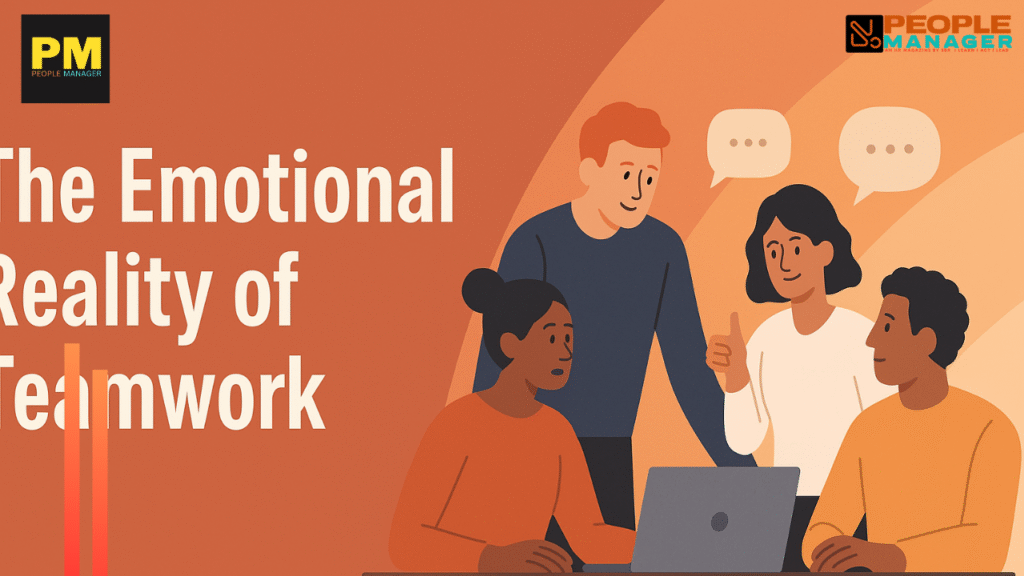The Emotional Reality of Teamwork: A Leadership Wake-Up Call
A leadership retreat filled with optimism. A team-building workshop that promises transformation. A catchy slogan on the wall about “collaborating to win.” And yet, days or weeks later, the old silos return. Passive resistance resurfaces. Trust takes a back seat. What’s going wrong? Teamwork.

As leaders, we talk a lot about team building. We invest in training, workshops, and modules designed to foster collaboration and build workplace relationships. And in theory, it all sounds promising. But let’s be honest—the real world of workplace collaboration isn’t quite so ideal.
The truth is: teamwork isn’t mechanical—it’s emotional.
The Human Disconnect Behind “Teamwork Training”
Training programs do a decent job of outlining behaviors we should adopt in a team—communicate openly, support one another, resolve conflict, share credit. But the unsaid assumption behind many of these efforts is that people operate in a vacuum, devoid of emotion.
They don’t.
Humans bring their full selves to work—including insecurities, egos, personal aspirations, traumas, and needs that often conflict with “ideal” behaviors taught in workshops.
- Ego can shut down openness.
- Insecurity can trigger resistance or withholding behavior.
- Unmet needs—recognition, growth, psychological safety—lead to disengagement or passive sabotage.
We need to stop ignoring these realities. The moment we begin to acknowledge them, team dynamics begin to make more sense—and become more manageable.
Why Teams Break Down (Even with the Best Intentions)
It’s not that people don’t want to collaborate. It’s that collaboration feels risky in the absence of certain emotional and psychological conditions. You might hear someone say, “Of course I support the team,” but deep inside they might wonder:
“If I help too much, will my contribution be overshadowed?”
“Will I lose control or relevance?”
“What if I become dispensable?”
These aren’t isolated fears—they’re everyday emotions that play out in meetings, emails, and project reviews. When people feel insecure, they act defensively. When their ego is bruised, they withdraw. When they don’t feel seen, they stop contributing meaningfully.
This is the emotional undercurrent most training programs don’t address—but as leaders, we must.
The Emotional Ecosystem of Teams
Let’s reframe teamwork not as a process or competency, but as a relationship ecosystem. Each individual in your team is navigating their emotional terrain—and their behavior is often a reflection of what that terrain looks like.
Here’s the nuance that rarely gets voiced in leadership circles:
- People don’t collaborate because they’re told to. They collaborate when they feel safe, valued, and acknowledged.
- When someone’s ego is at risk, even a brilliant idea will be met with resistance.
- When individuals feel invisible or irreplaceable, they’ll withhold support—not out of malice, but out of self-preservation.
Understanding this can completely transform how we lead.
Emotional Intelligence: The Real Team Building Skill
Instead of asking “how do I make this team more effective?” ask:
“What does this team need to feel safe, heard, and seen?”
That shift—from control to curiosity—moves leaders into the realm of emotional intelligence. It’s not just about being empathetic; it’s about navigating power dynamics, recognizing emotional cues, addressing unspoken tensions, and creating systems that value fairness and acknowledgment.
Your ability to notice and navigate emotional subtext is more vital than your ability to conduct performance reviews or give motivational speeches.
Through the Lens of Tuckman’s Team Development Model
Dr. Bruce Tuckman’s five stages of team development offer a helpful, structured lens—but only when interpreted through an emotional filter:
| Stage | What It Looks Like Emotionally |
|---|---|
| Forming | Politeness masks anxiety. People are scanning for psychological safety. |
| Storming | Egos rise. Turf wars begin. Hierarchies and insecurities surface. |
| Norming | Tentative trust builds. People start aligning emotionally. |
| Performing | High trust, mutual respect, healthy vulnerability = high results. |
| Adjourning | Transition anxiety. Emotional closure becomes necessary. |
Knowing these stages isn’t enough. Leaders must recognize the emotions behind each phase and guide the team accordingly.
Practical Shifts for Emotionally-Aware Leadership
Here are five shifts to make if you want to translate theoretical collaboration into lived team experience:
1. From Icebreakers to Insights
Icebreakers and team games have their place—but they’re not a substitute for emotional understanding. Instead, initiate conversations about what drives people, what makes them feel safe, and how they want to grow.
2. From Hierarchy to Humanity
Titles can command compliance—not commitment. Instead of pulling rank, lead with humility. People respond to authenticity, not authority for authority’s sake.
3. From Avoidance to Conversation
Conflict isn’t the enemy—avoidance is. Equip your team with tools to speak honestly, listen openly, and resolve emotionally-charged issues without fear of blame.
4. From Uniform Policies to Individual Meaning
What motivates one team member may drain another. Move beyond one-size-fits-all motivation. Get to know what each person values—growth, recognition, flexibility, autonomy—and build your systems around it.
5. From Preaching Values to Embodying Them
No amount of posters on “Trust” and “Respect” can make up for a leader who doesn’t practice them daily. Leadership credibility is emotional currency—it’s earned through small, consistent actions that demonstrate fairness, listening, and integrity.
Safe Spaces Aren’t Soft—They’re Strategic
Let’s be clear: this isn’t about making teams “nice.” It’s about making them resilient and effective.
Safe spaces aren’t coddling environments—they’re ecosystems where people can challenge ideas without attacking character, give feedback without fear, and admit mistakes without shame.
In such environments, collaboration flourishes not because it’s mandated—but because it’s emotionally sustainable.
The Strategic Takeaway
Team building, when stripped of its buzzwords, is about creating emotional fluency in the workplace.
Success happens when:
- Emotional intelligence is prioritized over technical competence.
- Mutual respect is embedded into the culture—not enforced by rules.
- Every individual knows they matter—and are reminded of it often.
Until we stop treating teamwork as a checkbox or KPI and start treating it as the emotional art of leadership, the gap between what’s taught and what’s lived will persist.
But the moment we embrace the full emotional reality of teamwork, that’s when transformation begins—not just for teams, but for leaders too. For further insights into the evolving workplace paradigm, visit
- Revolution in Talent Acquisition: Building the AI + Human Power Team - October 27, 2025
- Organizational Politics: Dynamics, Drivers, and the Cost of Influence - October 3, 2025
- Talent Management Challenges: Why Employees Don’t Recommend Their Own Companies - August 18, 2025








